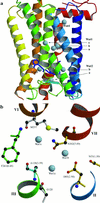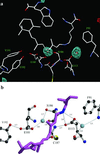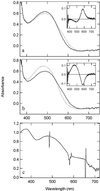Functional role of internal water molecules in rhodopsin revealed by X-ray crystallography
- PMID: 11972040
- PMCID: PMC122888
- DOI: 10.1073/pnas.082666399
Functional role of internal water molecules in rhodopsin revealed by X-ray crystallography
Abstract
Activation of G protein-coupled receptors (GPCRs) is triggered and regulated by structural rearrangement of the transmembrane heptahelical bundle containing a number of highly conserved residues. In rhodopsin, a prototypical GPCR, the helical bundle accommodates an intrinsic inverse-agonist 11-cis-retinal, which undergoes photo-isomerization to the all-trans form upon light absorption. Such a trigger by the chromophore corresponds to binding of a diffusible ligand to other GPCRs. Here we have explored the functional role of water molecules in the transmembrane region of bovine rhodopsin by using x-ray diffraction to 2.6 A. The structural model suggests that water molecules, which were observed in the vicinity of highly conserved residues and in the retinal pocket, regulate the activity of rhodopsin-like GPCRs and spectral tuning in visual pigments, respectively. To confirm the physiological relevance of the structural findings, we conducted single-crystal microspectrophotometry on rhodopsin packed in our three-dimensional crystals and show that its spectroscopic properties are similar to those previously found by using bovine rhodopsin in suspension or membrane environment.
Figures



References
-
- Hofmann K P. In: Handbook of Biological Physics: Molecular Mechanisms in Visual Transduction. Stavenga D G, Degrip W J, Pugh E N Jr, editors. Vol. 3. New York: Elsevier/North–Holland; 2000. pp. 91–142.
-
- Yoshizawa T. Photochem Photobiol. 1992;56:859–867. - PubMed
-
- Schertler G F, Villa C, Henderson R. Nature (London) 1993;362:770–772. - PubMed
-
- Palczewski K, Kumasaka T, Hori T, Behnke C A, Motoshima H, Fox B A, Le Trong I, Teller D C, Okada T, Stenkamp R E, et al. Science. 2000;289:739–745. - PubMed
Publication types
MeSH terms
Substances
Associated data
- Actions
LinkOut - more resources
Full Text Sources
Other Literature Sources
Molecular Biology Databases

